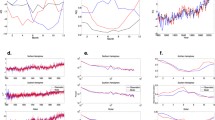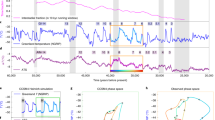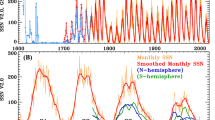Abstract
Though the Boltzmann–Gibbs framework of equilibrium statistical mechanics has been successful in many arenas, it is clearly inadequate for describing many interesting natural phenomena driven far from equilibrium. The simplest step towards that goal is a better understanding of nonequilibrium steady-states (NESS). Here we focus on one of the distinctive features of NESS—persistent probability currents—and their manifestations in our climate system. We consider the natural variability of the steady-state climate system, which can be approximated as a NESS. These currents must form closed loops, which are odd under time reversal, providing the crucial difference between systems in thermal equilibrium and NESS. Seeking manifestations of such current loops leads us naturally to the notion of “probability angular momentum” and oscillations in the space of observables. Specifically, we will relate this concept to the asymmetric part of certain time-dependent correlation functions. Applying this approach, we propose that these current loops give rise to preferred spatio-temporal patterns of natural climate variability that take the form of climate oscillations such as the El-Niño Southern Oscillation (ENSO) and the Madden–Julian Oscillation (MJO). In the space of climate indices, we observe persistent currents and define a new diagnostic for these currents: the probability angular momentum (\(\mathscr {L}\)). Using the observed climatic time series of ENSO and MJO, we compute both the averages and the distributions of \(\mathscr {L}\). These results are in good agreement with the analysis from a linear Gaussian model. We propose that, in addition to being a new quantification of climate oscillations across models and observations, the probability angular momentum provides a meaningful characterization for all statistical systems in NESS.


Similar content being viewed by others
Notes
In much of the physics community, “phase space” is a term used for the space of x–p (coordinate and momentum). Significantly, these variables are even/odd under time reversal. In this paper, however, we use this term in the sense common in the dynamical systems and climate science communities. In the cases we consider here, there is no reason to regard the variables (e.g., temperature and volume, or two amplitudes of a principal component analysis) as having different symmetry under time reversal. For many in the community of statistical physics, the familiar term in this context is “configuration space.” We will use the two terms interchangeably and assume there is no confusion.
Below, we will be considering time-dependent distributions, which we denote by \(P\left( C;t\right) \). The superscript (\(^{*}\)) signifies a stationary distribution.
Though the form of our equation appears to be for continuous t and discrete C, it is simple to write equations for other types of variables, e.g., continuous t and C. Note that we have restricted ourselves to systems evolving with time-independent rates.
In this form, the criterion for the W’s to satisfy DB appears to depend on \(P^{*}\). Kolmogorov [37] provided a criterion which involves only the W’s.
Note that the discrete version of the \(\delta \) in the noise correlation is a Kronecker delta of the time steps divided by \(\varepsilon \). Note also that there is no correlation between \({\mathbf {x}}\left( t\right) \) and \(\varvec{\eta }\left( t\right) \), so that \( < {\mathbf {x}}\left( t\right) \varvec{\eta }\left( t\right) > \equiv 0\).
The \(D_{\alpha \beta }\) here is the same as the one introduced above, the only difference being it is restricted to be x-independent in a LGM.
To avoid confusion, we use different notation for quantities in a LGM from the general case, e.g., p and \({\mathbf {j}}\) instead of P and \({\mathbf {K}}\).
Here, \( <\mathscr {O}> ^{*}\) refers to the average in the stationary state: \(\int \mathscr {O}\left( {\mathbf {x}}\right) p^{*}\left( {\mathbf {x}}\right) d{\mathbf {x}}\).
Note that we use the same letter for both the density of a quantity and the total, the former having an additional argument, \({\mathbf {x}}\).
Note that “diffusion” in this case also carries these units, as it is the noise covariance matrix.
References
Schmidt, G.: The physics of climate modeling. Phys. Today 60, 72 (2007). https://doi.org/10.1063/1.2709569
Reichl, L.E., Prigogine, I.: A Modern Course in Statistical Physics. University of Texas Press, Austin (1980)
Gallavotti, G.: Nonequilibrium and Irreversibility. Springer, Cham (2014)
Parrondo, J.M.R., Horowitz, J.M., Sagawa, T.: Thermodynamics of information. Nat. Phys. 11, 131–139 (2015)
Seifert, U.: Stochastic thermodynamics, fluctuation theorems and molecular machines. Rep. Prog. Phys. 75(12), 126001 (2012)
Hill, T.L.: Studies in irreversible thermodynamics iv. diagrammatic representation of steady state fluxes for unimolecular systems. J. Theor. Biol. 10(3), 442–459 (1966)
Zia, R.K.P., Schmittmann, B.: Probability currents as principal characteristics in the statistical mechanics of non-equilibrium steady states. J. Stat. Mech. Theory Exp. 2007(07), P07012 (2007)
Suzuki, N., Fox-Kemper, B., Hamlington, P.E., Van Roekel, L.P.: Surface waves affect frontogenesis. J. Geophys. Res. Oceans 121, 1–28 (2016)
Shkarayev, M.S., Zia, R.K.P.: Exact results for a simple epidemic model on a directed network: explorations of a system in a nonequilibrium steady state. Phys. Rev. E 90(3), 032107 (2014)
Mellor, A., Mobilia, M., Zia, R.K.P.: Characterization of the nonequilibrium steady state of a heterogeneous nonlinear q-voter model with zealotry. Europhys. Lett. (EPL) 113(4), 48001 (2016)
Mellor, A., Mobilia, M., Zia, R.K.P.: Heterogeneous out-of-equilibrium nonlinear \(q\)-voter model with zealotry. Phys. Rev. E 95, 012104 (2017)
Zia, R.K.P., Weiss, J.B., Mandal, D., Fox-Kemper, B.: Manifest and subtle cyclic behavior in nonequilibrium steady states. J. Phys. 750, 012003 (2016)
Lorenz, E.N.: Available potential energy and the maintenance of the general circulation. Tellus 7(2), 157–167 (1955)
Peixoto, J.P., Oort, A.H.: Physics of Climate. AIP-Press, New York (1992)
Pauluis, O., Held, I.M.: Entropy budget of an atmosphere in radiative-convective equilibrium. part i: maximum work and frictional dissipation. J. Atmos. Sci. 59(2), 125–139 (2002)
Lucarini, V.: Thermodynamic efficiency and entropy production in the climate system. Phys. Rev. E 80, 021118 (2009). https://doi.org/10.1103/PhysRevE.80.021118
Lucarini, V., Blender, R., Herbert, C., Ragone, F., Pascale, S., Wouters, J.: Mathematical and physical ideas for climate science. Rev. Geophys. 52(4), 809–859 (2014)
Laliberté, F., Zika, J., Mudryk, L., Kushner, P.J., Kjellsson, J., Döös, K.: Constrained work output of the moist atmospheric heat engine in a warming climate. Science 347(6221), 540–543 (2015). https://doi.org/10.1126/science.1257103
Wang, C.: A review of ENSO theories. Natl. Sci. Rev. 5(6), 813–825 (2018)
Wang, C., Deser, C., Yu, J.Y., DiNezio, P., Clement, A.: El niño and southern oscillation (ENSO): a review. In: Glynn, P.W., Manzello, D.P., Enochs, I.C. (eds.) Coral Reefs of the Eastern Tropical Pacific: Persistence and Loss in a Dynamic Environment, pp. 85–106. Springer, Dordrecht (2017)
Meinen, C.S., McPhaden, M.J.: Observations of warm water volume changes in the equatorial pacific and their relationship to El Niño and La Niña. J. Clim. 13, 3551–3559 (2000)
Zhang, C.: Madden-Julian oscillation. Rev. Geophys. (2005). https://doi.org/10.1029/2004RG000158
Newman, M., Alexander, M.A., Ault, T.R., Cobb, K.M., Deser, C., Di Lorenzo, E., Mantua, N.J., Miller, A.J., Minobe, S., Nakamura, H., Schneider, N., Vimont, D.J., Phillips, A.S., Scott, J.D., Smith, C.A.: The pacific decadal oscillation, revisited. J. Clim. 29(12), 4399–4427 (2016)
Knight, J.R., Folland, C.K., Scaife, A.A.: Climate impacts of the atlantic multidecadal oscillation. Geophys. Res. Lett. (2006). https://doi.org/10.1029/2006GL026242
Neale, R.B., Richter, J.H., Jochum, M.: The impact of convection on ENSO: from a delayed oscillator to a series of events. J. Clim. 21(22), 5904–5924 (2008)
Kiladis, G.N., Wheeler, M.C., Haertel, P.T., Straub, K.H., Roundy, P.E.: Convectively coupled equatorial waves. Rev. Geophys. (2009). https://doi.org/10.1029/2008RG000266
Timmermann, A., An, S.I., Kug, J.S., Jin, F.F., Cai, W., Capotondi, A., Cobb, K.M., Lengaigne, M., McPhaden, M.J., Stuecker, M.F., Stein, K., Wittenberg, A.T., Yun, K.S., Bayr, T., Chen, H.C., Chikamoto, Y., Dewitte, B., Dommenget, D., Grothe, P., Guilyardi, E., Ham, Y.G., Hayashi, M., Ineson, S., Kang, D., Kim, S., Kim, W., Lee, J.Y., Li, T., Luo, J.J., McGregor, S., Planton, Y., Power, S., Rashid, H., Ren, H.L., Santoso, A., Takahashi, K., Todd, A., Wang, G., Wang, G., Xie, R., Yang, W.H., Yeh, S.W., Yoon, J., Zeller, E., Zhang, X.: El niño-southern oscillation complexity. Nature 559(7715), 535–545 (2018). https://doi.org/10.1038/s41586-018-0252-6
Wheeler, M.C., Hendon, H.H.: An all-season real-time multivariate MJO index: development of an index for monitoring and prediction. Monthly Weather Rev. 132(8), 1917–1932 (2004)
Uhlenbeck, G.E., Ornstein, L.S.: On the theory of the brownian motion. Phys. Rev. 36, 823–841 (1930)
Penland, C., Magorian, T.: Prediction of Nino 3 sea surface temperatures using linear inverse modeling. J. Clim. 6(6), 1067–1076 (1993)
Penland, C., Matrosova, L.: Prediction of tropical atlantic sea surface temperatures using linear inverse modeling. J. Clim. 11, 483–496 (1998)
Alexander, M.A., Matrosova, L., Penland, C., Scott, J.D., Chang, P.: Forecasting pacific ssts: linear inverse model predictions of the PDO. J. Clim. 21(2), 385–402 (2008)
Hawkins, E., Sutton, R.: Decadal predictability of the atlantic ocean in a coupled gcm: forecast skill and optimal perturbations using linear inverse modeling. J. Clim. 22(14), 3960–3978 (2009)
Cavanaugh, N.R., Allen, T., Subramanian, A., Mapes, B., Seo, H., Miller, A.J.: The skill of atmospheric linear inverse models in hindcasting the Madden-Julian oscillation. Clim. Dyn. 44(3), 897–906 (2015)
Dias, D.F., Subramanian, A., Zanna, L., Miller, A.J.: Remote and local influences in forecasting pacific sst: a linear inverse model and a multimodel ensemble study. Clim. Dyn. 52(5–6), 3183–3201 (2018)
Stevenson, S., Rajagopalan, B., Fox-Kemper, B.: Generalized linear modeling of the el nino/southern oscillation with application to seasonal forecasting and climate change projections. J. Geophys. Res. Oceans 118(8), 3764–3781 (2013)
Kolmogoroff, A.: Zur theorie der markoffschen ketten. Math. Ann. 112, 115–160 (1936)
Riskin, H.: The Fokker-Planck equation methods of solution and applications, 2nd edn. Springer-Verlag, Berlin (1989)
Lax, M.: Fluctuations from the nonequilibrium steady state. Rev. Mod. Phys. 32(1), 25 (1960)
Weiss, J.B.: Coordinate invariance in stochastic dynamical systems. Tellus A 55(3), 208–218 (2003)
Russell, D.I., Blythe, R.A.: Macroscopically observable probability currents in finite populations. J. Stat. Mech. Theory Exp. 2013(06), P06008 (2013)
Ciliberto, S., Imparato, A., Naert, A., Tanase, M.: Heat flux and entropy produced by thermal fluctuations. Phys. Rev. Lett. 110, 180601 (2013). https://doi.org/10.1103/PhysRevLett.110.180601
Lévy, M.P.: Le mouvement brownien plan. Am. J. Math 62(1), 487–550 (1940)
Helmes, K., Schwane, A.: Levy’s stochastic area formula in higher dimensions. J. Funct. Anal. 54(2), 177–192 (1983)
Ghanta, A., Neu, J.C., Teitsworth, S.: Fluctuation loops in noise-driven linear dynamical systems. Phys. Rev. E 95, 032128 (2017)
Gonzalez, J.P., Neu, J.C., Teitsworth, S.W.: Experimental metrics for detection of detailed balance violation. Phys. Rev. E 99, 022143 (2019)
Batchelor, G.K.: Diffusion in a field of homogeneous turbulence. J. Fluid Mech. 214, 535–557 (1952)
Dukowicz, J., Smith, R.: Stochastic theory of compressible turbulent fluid transport. Phys. Fluids 9, 3523–3529 (1997)
LaCasce, J.H.: Statistics from Lagrangian observations. Prog. Oceanogr. 77, 1–29 (2008)
Imbrie, J., Berger, A., Boyle, E., Clemens, S., Duffy, A., Howard, W., Kukla, G., Kutzbach, J., Martinson, D., McIntyre, A., et al.: On the structure and origin of major glaciation cycles 2. The 100,000-year cycle. Paleoceanography 8(6), 699–735 (1993)
Wolter, K., Timlin, M.S.: El Niño/southern oscillation behaviour since 1871 as diagnosed in an extended multivariate ENSO index (MEI. ext). Int. J. Climatol. 31(7), 1074–1087 (2011)
Trouet, V., Van Oldenborgh, G.J.: Knmi climate explorer: a web-based research tool for high-resolution paleoclimatology. Tree-Ring Res. 69(1), 3–13 (2013)
Kiladis, G.N., Dias, J., Straub, K.H., Wheeler, M.C., Tulich, S.N., Kikuchi, K., Weickmann, K.M., Ventrice, M.J.: A comparison of OLR and circulation-based indices for tracking the MJO. Mon. Weather Rev. 142(5), 1697–1715 (2014)
Winkler, C.R., Newman, M., Sardeshmukh, P.D.: A linear model of wintertime low-frequency variability. part i: formulation and forecast skill. J. Clim. 14(24), 4474–4494 (2001)
Kirtman, B., Shukla, J., Balmaseda, M., Graham, N., Penland, C., Xue, Y., Zebiak, S.: Current status of ENSO forecast skill. A report to the Climate Variability and Predictability (CLIVAR) Numerical Experimentation Group (NEG), CLIVAR Working Group on Seasonal to Interannual Prediction (2002)
Hawkins, E., Sutton, R.: Decadal predictability of the atlantic ocean in a coupled gcm: forecast skill and optimal perturbations using linear inverse modeling. J. Clim. 22(14), 3960–3978 (2009)
Acknowledgements
This work was supported in part by NSF INSPIRE Award #1245944 and NSF DMR #1507371. Work of JBW was partially carried out during a stay at the Institute for Marine and Atmospheric research Utrecht (Utrecht University, NL) which was supported by the Netherlands Centre for Earth System Science. Three of us (JBW, BF-K, RKPZ) are grateful for the hospitality of the MPIPKS, where some of this work was carried out during a workshop Climate Fluctuations and Non-Equilibrium Statistical Mechanics: an Interdisciplinary Dialogue in the summer of 2017. We would like to thank Kevin Bassler, Ronald Dickman and Beate Schmittmann for helpful discussions.
Author information
Authors and Affiliations
Corresponding author
Additional information
Communicated by Valerio Lucarini.
Publisher's Note
Springer Nature remains neutral with regard to jurisdictional claims in published maps and institutional affiliations.
Rights and permissions
About this article
Cite this article
Weiss, J.B., Fox-Kemper, B., Mandal, D. et al. Nonequilibrium Oscillations, Probability Angular Momentum, and the Climate System. J Stat Phys 179, 1010–1027 (2020). https://doi.org/10.1007/s10955-019-02394-1
Received:
Accepted:
Published:
Issue Date:
DOI: https://doi.org/10.1007/s10955-019-02394-1




